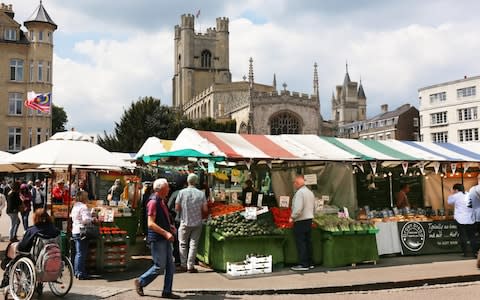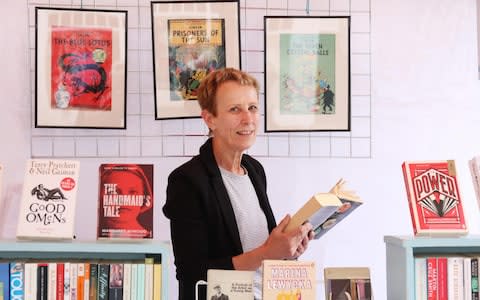Secrets of Britain’s most dynamic high street

In the second of a weekly series charting the fortunes of our national high streets, Rosa Silverman visits a town centre that seems to be thriving… but is it?
In Cambridge’s medieval Market Square on a Monday lunchtime, there’s a steady flow of customers, especially at the stalls selling street food. Indian, Thai, Chinese, Spanish: everything is priced reasonably and cooked fresh. In the shadow of the city’s historic university colleges, traders dish out dosas, curries and noodles to tourists and local workers.
Earlier this year, Cambridge topped a “vitality index” scoring centres on their retail health. The rankings, compiled by retail property advisers Harper Dennis Hobbs, were based on the proportion of upmarket shops and value-led shops, vacancy rates and the proportion of “low-quality” retailers such as pawnbrokers, money lenders and bookmakers. A higher score was given to areas whose stores were well-suited to the local community. The last time the index was published, in 2017, Cambridge also came top.
“The city benefits from its heritage as a centre for academia, as well as its location – less than an hour from London – which draws day-trippers as well as affluent residents,” explained James Ebel, chief executive of Harper Dennis Hobbs, at the time.
But behind the headline glad-tidings lies a rather more nuanced picture, as we discover in the second part of our series on the state of the high street. Even on the busy Market Square, in between stalls selling food, clothes, bags, flowers, fruit and vegetables and bicycle repairs, there’s a number of empty pitches, suggesting almost nowhere is immune from the difficulties afflicting town centres nationwide.
“The rents are set at a level that prices any innovative local start-up out of the market,” says Paul Richardson, joint owner of Full Circle, which sells plastic-free, reusable, sustainable, ethical and animal-free products at the market. “Even on busy days, we’re not as fully utilised as we could be. But we have our own niche, so that’s working well for us.”

Kate Kemp, who co-owns a secondhand book stall on the market, Bookish Cambridge, is likewise surprised to hear how well the city is doing. “We’ve definitely seen things changing, shops closing, in the last year,” she says. “The market has taken a downturn since 2017. I think the street food has kept it going.”
Her words echo those of certain non-food retailers trying to make a living a mile or so to the south east of the square, on Mill Road. Known locally for its independent and quirky retailers, this area has grown popular with hipsters, with property prices and rents rising to match. There’s a Chinese supermarket, a Middle Eastern supermarket, a Korean supermarket, a North African restaurant, a Jordanian cafe and countless other gastronomic venues. But for those not in the food and drink business, staying afloat can be harder.
“It’s all food,” sighs Tansy Tucker, who turned her father’s old pharmacy into The Old Chemist Shop Antique Centre about 12 years ago. “It’s cut out all the little shops. Food is fashionable.”
Her own business, by contrast, is “very quiet” and becoming more so. “You plod along, really,” she shrugs.
Pamela Wesson, owner of Fantasia & Friends, a vintage and retro fashion shop on the street, sounds similarly despondent. “I think people are concerned about spending money,” she says. “Things have fallen off.”
Still, much of Mill Road is booming compared to the Grafton Centre to the north. Despite its city centre location, this indoor shopping centre was ranked separately by Harper Dennis Hobbs, slipping 33 places to 423rd on the vitality index. “The largely mass-market centre has suffered multiple blows from store closures in recent years, including BHS, HMV and Mothercare, that have contributed to the overall vacancy rate of the area doubling over the past five years,” read the report.

Wander through the centre and you could be anywhere in struggling, chain-store Britain. The number of shoppers is small, the number of empty units noticeable. A mournful strain of musac drifts appositely through the main atrium. The centre’s bosses are offering small business owners and entrepreneurs the chance to win space here, rent-free, in one of many attempts nationwide to rethink the uses of what were once prime retail spaces.
In 2010, Cambridge earned itself another distinction, this one a little less enviable: it was, according to the New Economics Foundation, the worst clone town in the country. Its success in IT had brought money and people with it, which in turn had attracted the chain stores that required high footfall, reported the researchers. There was also the fact that many of the retail units are owned by the university colleges, which had either increased rents or sold off property to raise money.
Nine years on, the picture has not entirely changed. Chain stores still abound, and the fortunes of independents have been mixed. On the other hand, some praise the colleges for helping curate the local retail offering for the better.
“The colleges are really good at being picky about who opens a shop in Cambridge,” says Sarah Decent, who owns Modish, an independent shoe shop in the city. “My landlord is Trinity College, and when we’ve had vacancies on this street, they won’t let a nail bar or bookies or vape shop open.

"There was a vacancy next to my shop [on Green Street] for a few months and [Trinity] was pretty good at questioning people about their business plan. Some of the other colleges are a bit greedier and I’ve got friends who have been priced out.”
But if Cambridge is doing well regardless, with its shiny Grand Arcade full of upmarket and mid-market chain stores, and its lanes full of well-known high street brands, does the number of independents actually matter? Arguably, yes. Apart from the obvious negative connotations of the “clone town” moniker, fewer local businesses means less money circulating in the local economy, which can hamper economic resilience. In short, a good mix is essential for retail health.
Anne Beamish, co-founder of Indie Cambridge, has done more than most to help the city’s independent sector. Her company showcases what local retailers are doing, and has just started running academies to help them learn about everything from how to access funding to the best ways to use social media. She is naturally aware of how tough the current trading conditions are, but strikes a note of cautious optimism.

“The high street seems to have become a place where people socialise or sit in cafes and work, and that’s the sort of thing you can’t buy online, whereas retail is at the forefront of the difficulties,” she says. “But I’m starting to see certain shifts, because some of the bigger retailers have left, their massive units are still sitting there, and I’ve heard of [cases] where independents are being attracted back to them if they’re split into smaller units.”
The expertise, as well as the lesser carbon footprint, of many smaller, independent retailers are, she believes, real selling points. In other words, in a retail landscape dominated by the surviving big chains on the ground, and a boom in online shopping, there still remains a desire for something more personalised and experiential.
Sam Owens, founder of Thirsty, a four-year-old Cambridge bar and bottle shop business, is well aware of this quest for experience, and what we might loosely call authenticity.

“Spaces up and down cities all over the country have got to come up with other reasons to attract people in, and that’s about giving people the experience,” he says. To this end, his company also runs pop-up events, including German-inspired biergartens.
“These have been massive hits, and that’s partly because of the appetite from the population for unconventional, independent, quirky offerings,” he says.
At the same time, the value of a physical presence on the high street is declining, he believes. “People navigate via their phones now, and you find out about stuff through that same device, so the high street is less and less important. But it’s interesting how commercial uses of space in towns and cities is evolving. Just as there are frustrations and barriers, if you’re nimble enough and fleet-footed, there are opportunities as well.”
Next week: we visit Britain's unhealthiest high street

 Yahoo Finance
Yahoo Finance 